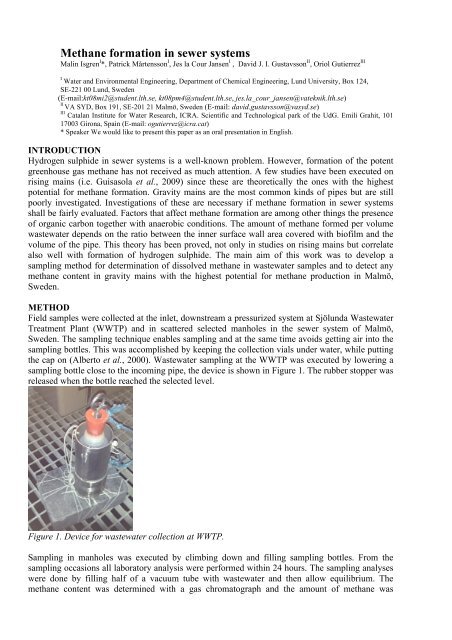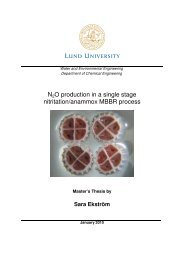Kemira Oyj/Kemira M&I ABSTRACT Vesa Kettunen ... - Svenskt Vatten
Kemira Oyj/Kemira M&I ABSTRACT Vesa Kettunen ... - Svenskt Vatten
Kemira Oyj/Kemira M&I ABSTRACT Vesa Kettunen ... - Svenskt Vatten
Create successful ePaper yourself
Turn your PDF publications into a flip-book with our unique Google optimized e-Paper software.
Methane formation in sewer systems<br />
Malin Isgren I *, Patrick Mårtensson I , Jes la Cour Jansen I , David J. I. Gustavsson II , Oriol Gutierrez III<br />
I<br />
Water and Environmental Engineering, Department of Chemical Engineering, Lund University, Box 124,<br />
SE-221 00 Lund, Sweden<br />
(E-mail:kt08mi2@student.lth.se, kt08pm4@student.lth.se, jes.la_cour_jansen@vateknik.lth.se)<br />
II<br />
VA SYD, Box 191, SE-201 21 Malmö, Sweden (E-mail: david.gustavsson@vasyd.se)<br />
III<br />
Catalan Institute for Water Research, ICRA. Scientific and Technological park of the UdG. Emili Grahit, 101<br />
17003 Girona, Spain (E-mail: ogutierrez@icra.cat)<br />
* Speaker We would like to present this paper as an oral presentation in English.<br />
INTRODUCTION<br />
Hydrogen sulphide in sewer systems is a well-known problem. However, formation of the potent<br />
greenhouse gas methane has not received as much attention. A few studies have been executed on<br />
rising mains (i.e. Guisasola et al., 2009) since these are theoretically the ones with the highest<br />
potential for methane formation. Gravity mains are the most common kinds of pipes but are still<br />
poorly investigated. Investigations of these are necessary if methane formation in sewer systems<br />
shall be fairly evaluated. Factors that affect methane formation are among other things the presence<br />
of organic carbon together with anaerobic conditions. The amount of methane formed per volume<br />
wastewater depends on the ratio between the inner surface wall area covered with biofilm and the<br />
volume of the pipe. This theory has been proved, not only in studies on rising mains but correlate<br />
also well with formation of hydrogen sulphide. The main aim of this work was to develop a<br />
sampling method for determination of dissolved methane in wastewater samples and to detect any<br />
methane content in gravity mains with the highest potential for methane production in Malmö,<br />
Sweden.<br />
METHOD<br />
Field samples were collected at the inlet, downstream a pressurized system at Sjölunda Wastewater<br />
Treatment Plant (WWTP) and in scattered selected manholes in the sewer system of Malmö,<br />
Sweden. The sampling technique enables sampling and at the same time avoids getting air into the<br />
sampling bottles. This was accomplished by keeping the collection vials under water, while putting<br />
the cap on (Alberto et al., 2000). Wastewater sampling at the WWTP was executed by lowering a<br />
sampling bottle close to the incoming pipe, the device is shown in Figure 1. The rubber stopper was<br />
released when the bottle reached the selected level.<br />
Figure 1. Device for wastewater collection at WWTP.<br />
Sampling in manholes was executed by climbing down and filling sampling bottles. From the<br />
sampling occasions all laboratory analysis were performed within 24 hours. The sampling analyses<br />
were done by filling half of a vacuum tube with wastewater and then allow equilibrium. The<br />
methane content was determined with a gas chromatograph and the amount of methane was
















